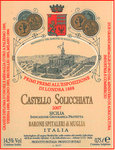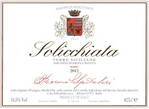| This winery was founded around 1850 by Baron Felice Spitaleri di Muglia, a wealthy entrepreneur and admirer of Bordeaux and Burgundy wines. He hired French oenologists to plant Cabernet Franc, Merlot, Cabernet Sauvignon, Syrah, Petit Verdot and Pinot Noir on the western slopes of Mount Etna. He also cultivated several Italian grapes varieties such as Nebbiolo, Grignolino, Sangiovese, Barbera, Pinot Bianco, Moscato and Nerello Mascalese. He was the first Sicilian grower to bottle dry wines and probably the first in Italy to produce a Bordeaux blend and a Pinot Noir. His wine, Castello Solicchiata, received several prestigious awards, such as the first prize at London in 1888. Baron Spitaleri was the first official supplier of the Royal House of Italy. The vineyards were destroyed by phylloxera in the early 1900's, save for a tiny parcel of about 100 vines. Spitaleri's direct descendants and present owners, Arnaldo and Felice Spitaleri, replanted in 2003. They continued the family tradition of wine-making using clones of French varietals planted in 1855. These have already begun to mutate, and are now considered Sicilian. The estate has about 15 hectares of vineyards, 800 to 1000 meters above sea level on the slopes of Mount Etna. Farming practices: The vineyard uses organic practices (but is not certified) and avoids the use of chemical fertilizers and pesticides. Grass grows between the vine rows and green harvesting is practiced. |
| Barone Spitaleri di Muglia Website |
 |
| Castello Solicchiata |
| 70% Cabernet Franc, 20% Merlot, 10% Cabernet Sauvignon. The sub-soil is composed of sandy gravel under volcanic soil. Plant density: 15,000/hectare. Gobelet method. Yields : only 10 hectoliters/hectare. Vines planted in 2003, exposure is south and west. The grapes are sorted upon arrival in the cellar, then de-stemmed and crushed, followed by 5 days of maceration at 39F in 35 hectoliter (5 year old) oak vats, and 20–30 days of fermentation in those vats (according to the varietal). Punch-down and racking is employed. Separate elevage of each varietal lasts 24 months in 100% new oak barrels ( 225 liter Bordeaux format ), followed by clarifying with albumin and a light filtering before blending. The estate chooses to cellar the wine after bottling for an additional three years, a rare practice that ensures a certain maturity for the consumer. On the nose Castello Solicchiata has hints of licorice, violets and earth, while the palate shows great density, with licorice, violets, underbrush, mushroom and finishes with a menthol-like freshness. Although the vines are quite young one never tastes the primary fruit aromas of the varieties. This is an elegant and complex Bordeaux blend with silky tannins and terroir-driven minerality. 2500 cases produced. |
 |
| Solicchiata |
| IGP Sicilia. 70% Cabernet Franc, 20% Merlot, 10% Cabernet Sauvignon. The sub-soil is composed of sandy gravel under black volcanic sand. Replanted in 2003, the vineyards are 800 meters (2625 feet) above sea level, with a south and west exposure. Plant density: 13,000/hectare. Gobelet method. Yields : only 10 hectoliters/hectare. The grapes are sorted upon arrival in the cellar, then destemmed and crushed. Fermentation in big oak vats and aging for 2 years in 225 liters used oak barrels. The wine is fined and lightly filtered. It spends an additional two years in bottle before release. 14.5% alcohol. 5830 cases produced. |
| Printer Friendly Version |
| Copyright © 2002-2017 VOS Selections, Inc. |